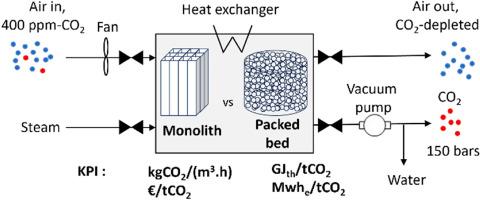Techno-economic analysis of packed bed and structured adsorbent for direct air capture
引用次数: 0
Abstract
This study investigates a direct air capture (DAC) process using a solid-DAC S-VTSA (steam-assisted vacuum thermal swing adsorption) process. A commercially available sorbent, commonly used in packed bed configurations, is selected as the benchmark sorbent, while a monolithic geometry is also examined to assess its potential performance. The process is modelled using Aspen Adsorption and incorporates physico-chemical data in DAC environmental conditions, including binary isotherms under humid condition. In a reference case comparing the two geometries, the packed bed exhibits higher productivity (2.4 kgCO2/(h.m3)), while the monolith achieves 1.2 kgCO2/(h.m3). However, the monolith allows for a significant reduction in pressure drop and associated fan work by about two orders of magnitude. These findings highlight the trade-off between productivity in favor of packed bed and energy requirement in favor of monolithic design. A sensitivity analysis is then conducted on various environmental and process parameters such as sorbent and bed dimension, air velocity, temperature and humidity, adsorption/desorption loading, mass transfer kinetic, and regeneration pressure, temperature, and steam flowrate. Detailed techno-economic analysis, using Aspen Process Economic Analyzer software for capital cost estimation, is performed at capture scale of 100 ktCO2/yr, with capture costs higher than 1500 €/tCO2.

填料床与结构吸附剂直接捕集空气的技术经济分析
本研究研究了采用固体DAC S-VTSA(蒸汽辅助真空热摇摆吸附)工艺的直接空气捕获(DAC)工艺。通常用于填充床配置的市售吸附剂被选为基准吸附剂,同时还检查了整体几何形状以评估其潜在性能。该过程采用了杨木吸附模型,并结合了DAC环境条件下的物理化学数据,包括潮湿条件下的二元等温线。在比较两种几何形状的参考案例中,填充床层的生产率更高(2.4 kgCO2/(h))。m3)),而整体达到1.2 kgCO2/(h.m3)。然而,这种整体结构可以显著降低压降,并将相关的风扇工作降低约两个数量级。这些发现强调了有利于填充床的生产率和有利于整体式设计的能源需求之间的权衡。然后对各种环境和工艺参数进行敏感性分析,如吸附剂和床层尺寸、空气速度、温度和湿度、吸附/解吸负荷、传质动力学、再生压力、温度和蒸汽流量。详细的技术经济分析,使用Aspen过程经济分析软件进行资本成本估算,在捕集规模为100千吨二氧化碳/年的情况下进行,捕集成本高于1500欧元/吨二氧化碳。
本文章由计算机程序翻译,如有差异,请以英文原文为准。
求助全文
约1分钟内获得全文
求助全文

 求助内容:
求助内容: 应助结果提醒方式:
应助结果提醒方式:


